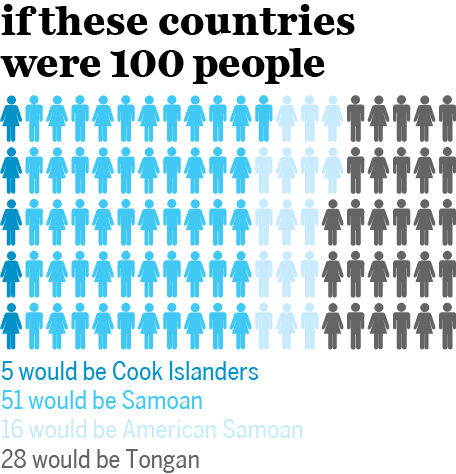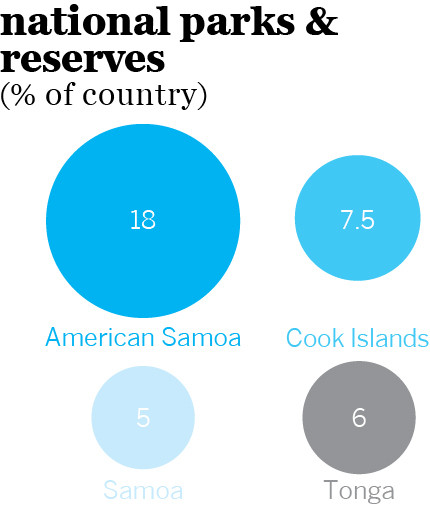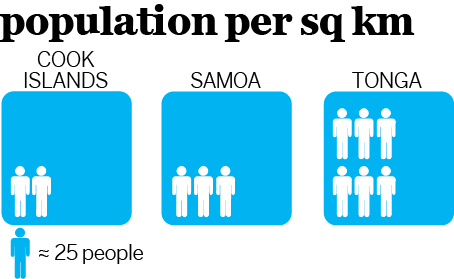Rarotonga, Samoa & Tonga Today
These island nations have much in common, but – strewn across a vast span of the South Pacific – they remain a varied bunch. It’s not all kava, cocktails and good times here: political change is par for the course, and the complex ties between regional allies, both old and new, are strengthened and weakened all the time. Locals are proving resourceful, though, upping the tourism ante with innovative enticements to visitors.
Best in Print
Pacific Tsunami Galu Afi (Lani Wendt Young; 2010) Details the impact of the 2009 tsunami that devastated parts of Samoa, American Samoa and Tonga.
Patterns of the Past: Tattoo Revival in the Cook Islands (Therese Mangos and John Utanga; 2011) Getting inked in the Cooks, from past to present.
Blue Latitudes (Tony Horwitz; 2002) Retraces Captain Cook’s epic voyages through the South Seas.
The Happy Isles of Oceania (Paul Theroux; 1992) Theroux kayaks through the South Pacific (try to overlook the mildly patronising title…).
Best on Film
Sione’s Wedding (director Chris Graham; 2006) Four Samoan lads get up to mischief in Auckland.
The Orator (director Tusi Tamasese; 2011) Love, courage and honour: the first 100% Samoan feature film.
My Lost Kainga (director Tony Fuemana; 2011) Tongan film exploring the loss of language and culture.
Mutiny on the Bounty (directors Frank Lloyd, Lewis Milestone and Roger Donaldson; 1935, 1962 and 1984, respectively) Captain Bligh and Fletcher Christian disagree.
Saying Hello
Kia orana (Cook Islands)
Talofa (Samoa)
Malo e lelei (Tonga)
Top Blogs
Sleepless in Samoa (www.sleeplessinsamoa.blogspot.co.nz)
Raro Lens: A Look at the Cooks (www.rarolens.com)
Samoa Food (www.samoafood.com)
Fagogo mai Samoa…aue! (www.savaii.blogspot.co.nz)
Etiquette
Beaches Beach access is often via local family land: ask permission before you barge through.
Souvenirs Don't buy items made from endangered resources like black coral or sandalwood.
Turtle Don't eat it – it’s endangered and you’ll be promoting illegal trade.
At the table Don't just dig in: many locals say grace before a meal.
Sports Stars
Kevin & Tony Iro The former rugby-league players have Cook Islands heritage.
Dwayne ‘The Rock’ Johnson The wrestler and chiselled Hollywood actor has a Samoan mum.
Jonah Lomu The former NZ All Blacks rugby-union superstar (RIP) had a Tongan background.
Tim Cahill The Australian soccer (football) star has a Samoan mum.
Sonny Bill Williams The badass All Black with the killer Samoan tatts has a Samoan dad.
The Political Landscape
By the time you read this, Samoa will have staged its 2016 general election – the country's first election since it hopped west of the International Date Line at the end of 2011 to align with key trading partners Australia and New Zealand. Has sitting prime minister Tuila'epa Sa'ilele Malielegaoi of the Human Rights Protection Party, top dog since 1998, been returned to power? Electoral integrity in the 2016 election was bolstered by the 10,000-plus Samoans who registered to vote for the first time, many of whom were no doubt encouraged by new laws to improve voting confidentiality. In the lead-up to the election, penalties for illicit coercion, infringement on voting secrecy or otherwise cooking the electoral books were upped from a minimum of three months' to 12 months' imprisonment.
In Tonga, new King George Tupou VI has been settling into the hot seat. Tonga was rocked in 2012 by the sudden death of the new king’s brother, King George Tupou V, aged 65, while visiting Hong Kong. Crowned only in 2008, he ceded many of his powers after ascending the throne to pave the way for democratic reform in the country. Some say this magnanimous move betrayed a lack of enthusiasm for the top job, suggesting that the king – something of a footloose bachelor – was more at home travelling overseas than, well…at home. But new King George VI, a deeply religious family man, has a much more earnest and caring reputation. His coronation in 2015 (postponed until this time so the country could raise the coin to bankroll the event with sufficient pomp) was a lavish affair, and he’s been very well received by an adoring public. And in the wake of the 2014 general election, where Tonga’s own brand of democracy again withstood the test of the proletariat, the pro-democracy riots of 2006 that tore up downtown Nuku’alofa seem a distant memory.
Meanwhile in the Cook Islands, in 2015 the country celebrated 50 years of self-governing independence from New Zealand. New Zealand prime minister John Key turned up for the party, which involved typically effervescent dancing displays and much feasting. In his address to the nation, Key pledged a donation of NZ$11.7 million towards the redevelopment of Rarotonga's national secondary school, on top of the NZ$42 million NZ will be contributing over the next three years towards infrastructure and health projects in the Cooks. That's good news for local prime minister Henry Puna, who is still pushing for the Cook Islands to gain a seat in the UN. As an aside to his address, Key suggested that while the Cooks remain so reliant on foreign aid from NZ, Australia and China, the chances of the UN acceding to Puna's proposal remain slim.
To keep up to speed with the often fast-changing political landscape right across the South Pacific, check out the comprehensive Pacific Islands Report (www.pireport.org), which includes updates on the Cook Islands, Samoa, American Samoa and Tonga.
Influences from Afar
New Zealand and Australia remain key foreign-aid donors to the Cook Islands, Samoa and Tonga. Recent projects in the region funded by NZ/Australian aid money include investments in solar and wind power; upgrading police infrastructure, training and equipment; and efforts to improve attendance and educational outcomes in island schools. However, the impact of Chinese and Japanese aid throughout this part of the South Pacific should not be underestimated: China’s influence, in particular, is becoming increasingly visible. Chinese road workers are a common sight in Tonga (look for the signs saying ‘China Road’); aid money from Beijing has funded several public buildings in the Samoan capital of Apia; and the main road and water systems on Rarotonga are currently being overhauled using Chinese money.
But this investment definitely comes with strings attached – namely, via the enactment of so-called Chinese 'soft power'. In the Cook Islands, for example, a Chinese workforce must be used for construction projects, and the Cooks must purchase equipment and goods from China to get the job done. Other perks for the Chinese include fishing licences and access to regional mineral and timber resources being subsequently granted to Chinese companies. Some Tongans we spoke with suggest that China's motives are also poli-military, looking to undermine regional ties between the South Pacific nations and Australia, Japan and the USA, with an eye to tactical naval expansion in the South Seas. Japan, too, has invested millions in services and infrastructure right across the South Pacific.
But regardless of criticism, it’s undeniable that this investment is very welcome and very timely. This is especially true in countries like Tonga, Samoa and American Samoa, where the local economies lean heavily on remittances sent home from family members living overseas. When times get tough for these second-generation families in Auckland, Sydney and Los Angeles, the natural inclination is to send less money back to their home islands, which seem increasingly far away and in time increasingly detached from day-to-day concerns.
Isolation Breeds Innovation
The global financial realm may remain a tad shaky in the wake of the crisis of 2007–08, but visitor numbers are still increasing year on year for the isolated isles of Samoa, the Cook Islands and Tonga. Within these countries, specific islands are developing innovative attractions to inspire traveller interest. ‘Atiu in the Cook Islands and the Tongan island of ‘Eua, for example, are becoming popular for birdwatching and ecotourism (hiking, diving and caving). Rarotonga is growing as a destination for foodies by moving away from a dependence on imported foodstuffs, while sea kayaking in the Ha'apai and Vava'u island groups in Tonga entices adventurous travellers. More broadly, Samoa has lately been garnering international attention as a sporting destination, with triathlons and ocean-swimming events luring fit bods from all over the planet. Across the region there's also a general move towards enabling visitors to have more authentic experiences, often by focusing on local food and accommodation. The feeling is that travellers want to break free of the confines of their resorts and really experience village life.
Combined Area
4131 sq km
Combined Population
373,750
Most Islands
Tonga (176)
Biggest City
Apia, Samoa (pop 36,735)
Highest Point
Mt Silisili, Samoa (1858m)


